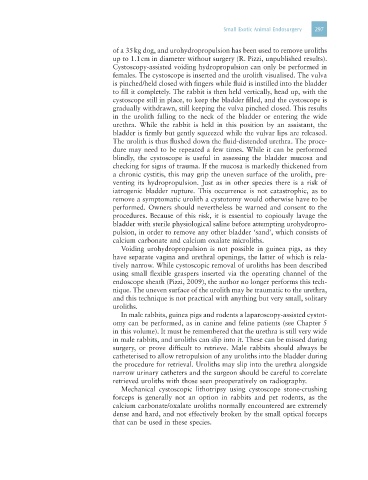Page 309 - Clinical Manual of Small Animal Endosurgery
P. 309
Small Exotic Animal Endosurgery 297
of a 35 kg dog, and urohydropropulsion has been used to remove uroliths
up to 1.1 cm in diameter without surgery (R. Pizzi, unpublished results).
Cystoscopy-assisted voiding hydropropulsion can only be performed in
females. The cystoscope is inserted and the urolith visualised. The vulva
is pinched/held closed with fingers while fluid is instilled into the bladder
to fill it completely. The rabbit is then held vertically, head up, with the
cystoscope still in place, to keep the bladder filled, and the cystoscope is
gradually withdrawn, still keeping the vulva pinched closed. This results
in the urolith falling to the neck of the bladder or entering the wide
urethra. While the rabbit is held in this position by an assistant, the
bladder is firmly but gently squeezed while the vulvar lips are released.
The urolith is thus flushed down the fluid-distended urethra. The proce-
dure may need to be repeated a few times. While it can be performed
blindly, the cystoscope is useful in assessing the bladder mucosa and
checking for signs of trauma. If the mucosa is markedly thickened from
a chronic cystitis, this may grip the uneven surface of the urolith, pre-
venting its hydropropulsion. Just as in other species there is a risk of
iatrogenic bladder rupture. This occurrence is not catastrophic, as to
remove a symptomatic urolith a cystotomy would otherwise have to be
performed. Owners should nevertheless be warned and consent to the
procedures. Because of this risk, it is essential to copiously lavage the
bladder with sterile physiological saline before attempting urohydropro-
pulsion, in order to remove any other bladder ‘sand’, which consists of
calcium carbonate and calcium oxalate microliths.
Voiding urohydropropulsion is not possible in guinea pigs, as they
have separate vagina and urethral openings, the latter of which is rela-
tively narrow. While cystoscopic removal of uroliths has been described
using small flexible graspers inserted via the operating channel of the
endoscope sheath (Pizzi, 2009), the author no longer performs this tech-
nique. The uneven surface of the urolith may be traumatic to the urethra,
and this technique is not practical with anything but very small, solitary
uroliths.
In male rabbits, guinea pigs and rodents a laparoscopy-assisted cystot-
omy can be performed, as in canine and feline patients (see Chapter 5
in this volume). It must be remembered that the urethra is still very wide
in male rabbits, and uroliths can slip into it. These can be missed during
surgery, or prove difficult to retrieve. Male rabbits should always be
catheterised to allow retropulsion of any uroliths into the bladder during
the procedure for retrieval. Uroliths may slip into the urethra alongside
narrow urinary catheters and the surgeon should be careful to correlate
retrieved uroliths with those seen preoperatively on radiography.
Mechanical cystoscopic lithotripsy using cystoscope stone-crushing
forceps is generally not an option in rabbits and pet rodents, as the
calcium carbonate/oxalate uroliths normally encountered are extremely
dense and hard, and not effectively broken by the small optical forceps
that can be used in these species.

